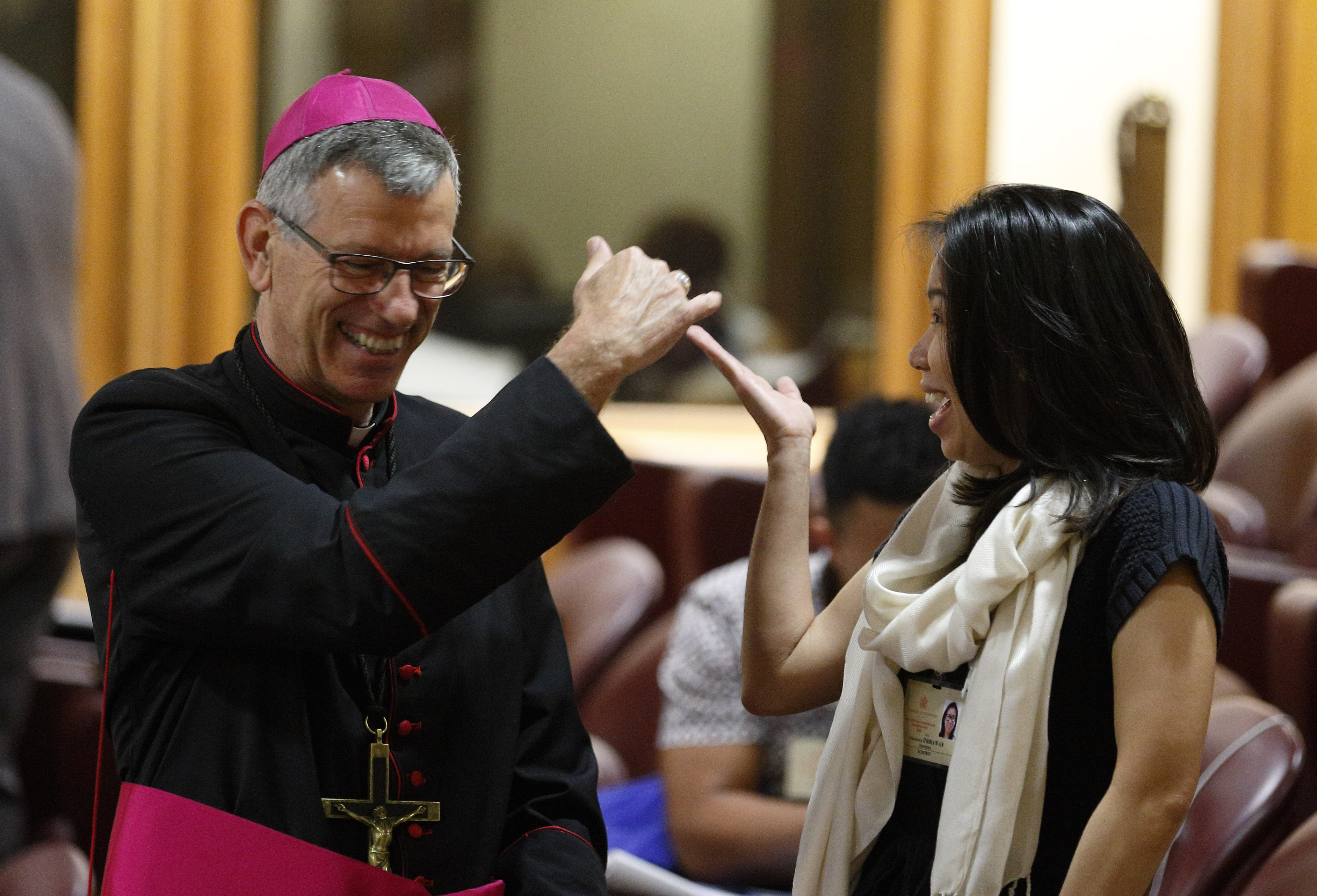
Auxiliary Bishop Mark Stuart Edwards of Melbourne, Australia, shares a laugh with Indonesian youth delegate Anastasia Indrawan before a session of the Synod of Bishops on young people, the faith and vocational discernment at the Vatican Oct. 9. (CNS photo/Paul Haring)
The Synod of Bishops powwow on the youth crisis has ended about how you’d expect. Nothing bridged the growing gap between a hierarchy worried about youth defections and young people who appear much less likely to become the equivalents of “cradle Catholics” than their elders had.
The bishops acknowledged the gap mostly by rehearsing remedies such as better Catholic education and acceptance of sexual minorities rather than exposing far deeper cultural and religious causes of the larger problem of irrelevance. The 34 young people sitting in were praised for showing zest for Catholicism, applauding speakers and listening carefully, in what seemed an effort to contradict the stereotype of lethargy and indifference.
I’m sure the bishops are earnest in their desire to turn the tide but the whole affair fell flat. Doubtful it could have been otherwise. The bishops are out of their depth and most young people who are leaving the church bear little to no resemblance to the small group of under-30s who were invited to participate. They have their own value and integrity, to be sure, but surely represent the shrinking proportion of church loyalists. Their witness is unimpeachable but they don’t pose the crisis.
Empathy for bishops is due. What we now call the generation gap is new to human history. Until rather recently, the lines between child and adult were often blurred. Work involved fathers, mothers and children sharing duties on farms and performing domestic trades; marriages took place near the onset of puberty; shorter life spans pressed stages of life more compactly; and rituals initiated the young to adult roles seamlessly. Confirmation was church citizenship rather than a way station between junior high and marriage.
As generations grew farther apart, elders have exercised piquant critiques of young ones they knew less about, venting a stream of complaints that the youngsters were sadly deficient in what they, as parents and grandparents, thought necessary to secure a sensible future. But nothing has compared to the wedge separating them by cyberspace. Now the gap wasn’t typically between older and younger, but between one way of seeing the world and another. The former understanding paved the way for the latter, of course, but the break was more radical and different in kind. Somewhere in that process, says the esteemed philosopher Charles Taylor in his monumental book A Secular Age, the capacity of the modern, computerized, increasingly empirical mind to accept supernaturalism has diminished. The cornerstone to Catholic faith are a cluster of supernatural beliefs. Therein lies the credibility crisis through no fault of the church itself. If the supernatural claims, supremely including Jesus’ divine nature, make no sense, how do you propagate the traditional creeds?
Young people and bishops roughly fall on opposite sides of that divide in my view. That places a much greater burden on a synod devoted to finding means of imbuing young people or any people with the depth of the Gospel. Strategies or practices may help some feel more comfortable but the core issue is, to put it too crudely, how do you sell the Christian message to this age which doesn’t feel hostile to it but for whom it simply makes no sense in their worlds of intense personal interaction with websites, texts and video games?
Auxiliary Bishop Thomas Dowd of Montreal referred indirectly to this dilemma at the synod. As quoted by the Catholic News Service, Bishop Dowd proposed that the assembly take a first step in response to unbelief by seeking to define God, explore why evil exists and whether God is doing anything about it? If Taylor and others are right, such questions go to the heart of the crisis and raise mighty challenges for answers to suit the cyber age. Coming up with credible answers — and that is no foregone conclusion — might give Catholic education a new lease on life. Bishop Dowd said his had been “an abysmal failure."
In the same article Cardinal Kurt Koch of Switzerland tells the gathering that nothing works better to spread faith than those who actually live it. Being better examples for young people could alleviate “the critical situation of the transmission of the faith today,” Cardinal Koch said.
Leading by example implies the existence of examples. But do they exist? An evangelical pastor told me recently he thinks they are in very short supply because church people don’t generally grow into Christian adulthood. With few exceptions, they stop developing their “faith minds” when their religious educations ends around age 12 and feel no need to continue. All the while, he said, they do feel it necessary to grow professionally and socially.
Mentors who can bring faith cultivated by learning and experience are surely part of an approach to those young strangers among us whose perspective is shaped by advanced technology. Reaching them would also appear to require sharing their world, being both an outsider with something new who also occupies their consciousness, serving up something still unforeseen, perhaps, laying aside the formulas of the past.
[Ken Briggs reported on religion for Newsday and The New York Times, has contributed articles to many publications, written four books and is an instructor at Lafayette College in Easton, Pennsylvania.]
Advertisement








